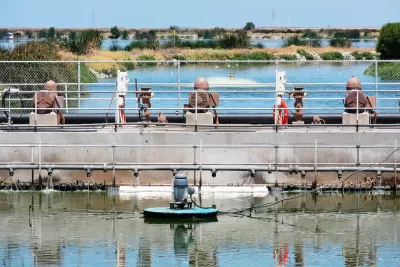The complex set of regulations will ensure recycled water makes it to taps safely.

California regulators approved the first standards for transforming sewage into potable water, reports Rachel Becker in CALmatters, paving the way for recycling and treating wastewater.
“The new rules — which have been more than a decade in the making and were mandated by a state law — outline a slew of requirements aimed at ensuring that germs and chemicals are scrubbed from treated sewage,” Becker explains.
The sewage will be bubbled with ozone, chewed by bacteria, filtered through activated carbon, pushed at high pressures through reverse osmosis membranes multiple times, cleansed with an oxidizer like hydrogen peroxide and beamed with high-intensity UV light. Valuable minerals, such as calcium, that were filtered out will be restored. And then, finally, the wastewater will be subjected to the regular treatment that all drinking water currently undergoes.
Colorado and Texas already have rules governing ‘toilet-to-tap,’ and Florida and Arizona are developing their own policies. After a final review, the California rules could be implemented sometime next year. A Southern California recycled water plant is under construction and could produce roughly 115 million gallons of water per day by 2032.
The recycled water will likely cost more than imported water, but will help secure California’s water future as water supplies in the West become more strained.
FULL STORY: California approves rules that turn sewage into drinking water

Study: Maui’s Plan to Convert Vacation Rentals to Long-Term Housing Could Cause Nearly $1 Billion Economic Loss
The plan would reduce visitor accommodation by 25,% resulting in 1,900 jobs lost.

Alabama: Trump Terminates Settlements for Black Communities Harmed By Raw Sewage
Trump deemed the landmark civil rights agreement “illegal DEI and environmental justice policy.”

Why Should We Subsidize Public Transportation?
Many public transit agencies face financial stress due to rising costs, declining fare revenue, and declining subsidies. Transit advocates must provide a strong business case for increasing public transit funding.

Paris Bike Boom Leads to Steep Drop in Air Pollution
The French city’s air quality has improved dramatically in the past 20 years, coinciding with a growth in cycling.

Why Housing Costs More to Build in California Than in Texas
Hard costs like labor and materials combined with ‘soft’ costs such as permitting make building in the San Francisco Bay Area almost three times as costly as in Texas cities.

San Diego County Sees a Rise in Urban Coyotes
San Diego County experiences a rise in urban coyotes, as sightings become prevalent throughout its urban neighbourhoods and surrounding areas.
Urban Design for Planners 1: Software Tools
This six-course series explores essential urban design concepts using open source software and equips planners with the tools they need to participate fully in the urban design process.
Planning for Universal Design
Learn the tools for implementing Universal Design in planning regulations.
Smith Gee Studio
Alamo Area Metropolitan Planning Organization
City of Santa Clarita
Institute for Housing and Urban Development Studies (IHS)
City of Grandview
Harvard GSD Executive Education
Toledo-Lucas County Plan Commissions
Salt Lake City
NYU Wagner Graduate School of Public Service




























